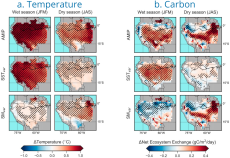Amazon Soil Moisture Impact on Carbon Dioxide Emissions

Figure: a. The difference between the mean temperature anomalies of El Niño years and those of La Niña years. Monthly anomalies are averaged across the wet season (JFM, left column) and dry season (JAS, right column). Each experiment (row) is described in the Approach section of the text. b. Same as a., but for monthly anomalies of net ecosystem exchange (positive is a flux to the atmosphere).
Soil moisture variability intensifies and prolongs eastern Amazon temperature and carbon cycle response to El Niño-Southern Oscillation
The Science
During El Niño events, atmospheric teleconnections with sea surface temperature (SST) anomalies in the equatorial Pacific cause higher temperatures and reduced rainfall in the Amazon, leading to increased CO2 emissions. While some of the temperature increase results directly from the SST-atmosphere teleconnection, drier soil resulting from reduced rainfall can also contribute to higher temperatures and resulting CO2 flux anomalies. Researchers from the University of California, Irvine and the Oak Ridge National Laboratory modified the Energy Exascale Earth System Model (E3SM) to decouple the direct effects of SST anomalies from the resulting soil moisture anomalies, in order to determine the relative importance of each of these drivers.
The Impact
Soil moisture variability was found to amplify and extend the effects of SST forcing on eastern Amazon temperature and carbon fluxes in E3SM. During the wet season, the direct, circulation-driven effect of ENSO SST anomalies dominated temperature and carbon cycle variability throughout the Amazon. During the following dry season, after ENSO SST anomalies had dissipated, soil moisture variability became the dominant driver in the east, explaining 67–82% of the temperature difference between El Niño and La Niña years, and 85–91% percent of the difference in carbon fluxes. These results highlight the need to consider the interdependence between temperature and hydrology when attributing the relative contribution of these factors to interannual variability of the terrestrial carbon cycle. Specifically, when offline models are forced with observations or reanalysis, the contribution of temperature may be overestimated when its own variability is modulated by hydrology via land-atmosphere coupling.
Summary
We demonstrated that in E3SM, soil moisture anomalies resulting from SST variability extended and strengthened the temperature and CO2 flux anomalies associated with ENSO. This indicates the need to consider the interdependent relationship between temperature and the hydrologic cycle when attributing mechanisms to ENSO-driven variability in the tropical terrestrial carbon cycle.
Publications
Levine, P. A., J. T. Randerson, Y. Chen, M. S. Pritchard, M. Xu, and F. M. Hoffman (2019), Soil moisture variability intensifies and prolongs eastern Amazon temperature and carbon cycle response to ElNiño-SouthernOscillation,J.Clim.,32(4):1273–1292,doi:1 0.1175/JCLI-D-18-0150.1.
Related Links
● Reducing Uncertainties in Biogeochemical Interactions through Synthesis and Computation (RUBISCO) Scientific Focus Area https://www.bgc-feedbacks.org/● Energy Exascale Earth System Model (E3SM) https://e3sm.org/
● Next Generation Ecosystem Experiments–Tropics (NGEE-Tropics) https://ngee-tropics.lbl.gov/
About NERSC and Berkeley Lab
The National Energy Research Scientific Computing Center (NERSC) is a U.S. Department of Energy Office of Science User Facility that serves as the primary high performance computing center for scientific research sponsored by the Office of Science. Located at Lawrence Berkeley National Laboratory, NERSC serves almost 10,000 scientists at national laboratories and universities researching a wide range of problems in climate, fusion energy, materials science, physics, chemistry, computational biology, and other disciplines. Berkeley Lab is a DOE national laboratory located in Berkeley, California. It conducts unclassified scientific research and is managed by the University of California for the U.S. Department of Energy. »Learn more about computing sciences at Berkeley Lab.







